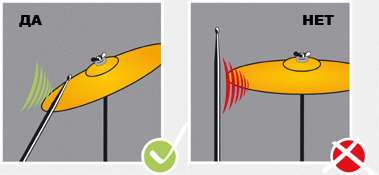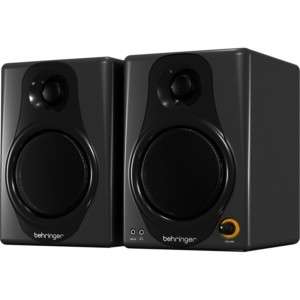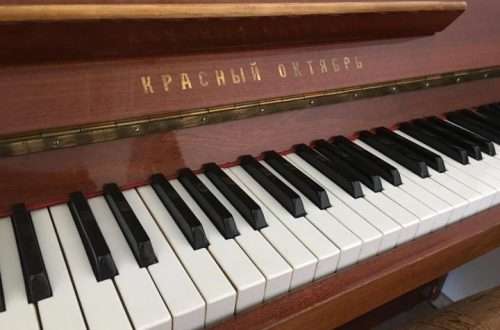
How to choose cymbals for your drum kit
Contents
Cymbals are a percussion musical instrument with an indefinite pitch. Plates have been known since ancient times , found in Armenia (VII century BC), China, India, later in Greece and Turkey.
They are a convex-shaped disk made of special alloys by casting and subsequent forging. There is a hole in the center of the cymbal for fixing the instrument on a special stand.
Among the main techniques of the game: hitting suspended cymbals with various sticks and mallets, hitting paired cymbals against each other, playing with a bow.
In jargon, musicians sometimes call a set of cymbals “iron”
In this article, the experts of the store “Student” will tell you how to choose the drum cymbals that you need, and not overpay at the same time.
Plate shapes
The shape of the curve of the cymbal has a huge impact on the sound. Shaping the curve of a cymbal is an essential process in shaping its basic sonic characteristic.
A flat bend has relatively less tension in the material. The basic sound of such a cymbal is warm and dark, with a quick response.
![]()
The middle bend creates tension in the material. Her basic tone is full and rich, with a medium accent and a direct response.
![]()
A sharp bend has a strong tension in the material. Its main sound is very powerful, with strong high frequencies and a clear, focused attack.

Modern types of plates
One of the main types of cymbals are crash cymbals , which produce a powerful wideband atonal sound when played. A pair of such cymbals are used as orchestral cymbals , and the sound is produced by striking the cymbals against each other. One or more single crash cymbals are used in drum kits, and the sound is most often produced by hitting the shoulder of the stick against the edge of the cymbal . In both cases crash cymbals are mainly used for playing accents.
Crash cymbals are produced in a wide range of weights, from very thin to very heavy, but the edge of the cymbal must be fairly thin . In general, the profile of crash cymbals is characterized by the greatest thickness at the dome, gradually decreasing towards the edge, due to which crashes have a dense broadband sound .
The typical size (diameter) of crash cymbals is 16″ or 18″, although major manufacturers offer cymbals from 14″ to 20″, and custom-made cymbals from 8″ to 28″. Pairs of orchestral cymbals typically range in diameter from 16″ to 21″, but pairs up to 5″ are produced.
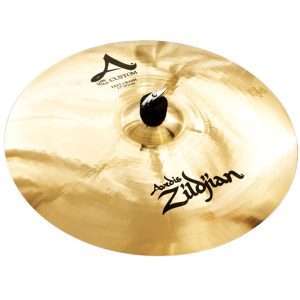
crash cymbal ZILDJIAN 17` A` CUSTOM CRASH
Hi-hat (English hi-hat or hihat), often referred to simply as “hat” is another type of paired cymbals that have orchestral cymbals in their origins . A hi-hat is a pair of cymbals (the profile is the same as crash) mounted on a special stand with a foot mechanism that allows you to hit one cymbal against another, and the design of this stand has changed little since its inception.
In general, a distinction is made between open ( the cymbals are apart) and closed ( the cymbals are touching because the pedal is depressed) position of the hi-hat , and the sound is produced both by hitting the stick in both of these positions, and by pressing the pedal with your foot, as a result of which the cymbals hit each other.

Hi-hat cymbals SABIAN 14″ AAX X-PLOSION BRILLIANT
When played , a ride-type cymbal produces a long ringing, somewhat hissing sound, in contrast to the rapidly fading sound of a crash. The most commonly used rides are 20″ in diameter, but sizes from 18″ to 22″ are considered standard. Major manufacturers make rides from 16″ to 26″ in diameter , but it is possible to find rides up to 8″.
The bigger and thicker the ride, the better it sounds in louder music, and, unlike crashes, the edge of the ride’s cymbal is usually quite thick. Often the ride is the largest cymbal in the kit, but sometimes drummers use china or sizzle type cymbals as the second ride , which in this case are larger but thinner than the ride.
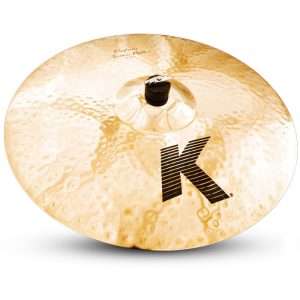
Ride cymbal ZILDJIAN 20` K` CUSTOM DARK RIDE
Sizzle -type cymbals are rides with some kind of rattle added to change the sound, most often rivets or chains.
This naturally makes the sound louder and more piercing, but reduces the dynamic range , because very quiet playing may not have enough energy to make the rattles vibrate.
Rivets are installed in the holes made in the plate, so that the rivets can oscillate, but do not fall out. In a classic sizzle plate, the rivets are located in several (usually four or more) holes, evenly spaced along the edge of the plate .
Countless experiments were also made on the location of the rivets in other places, but only one of them really gave something – this is the location on the plate of only three rivets in holes along the edge of the plate , but side by side. Such cymbals were very popular in the late 1980s and early 1990s, and it was even considered that they would completely replace conventional ride cymbals , but this did not happen.
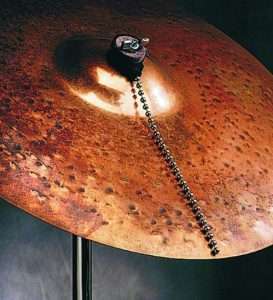
Sizzler effect for cymbals (chain with small balls)
Splash cymbals are small and thin cymbals that are (along with china cymbals) one of the main types of effect cymbals.
By design, splash is a very thin and small crash, and the body of the cymbal practically does not change thickness from dome to edge, and the dome is slightly thicker, so the emitted sound is perceived as “empty” and less dense than crash, but, nevertheless, cutting through and sharp attack.
Splash cymbals are used to play accents , most often syncopated (shifted accents from a strong beat to a weak beat), and they are usually played very hard. For quieter playing, some manufacturers offer thin splashes, which have a crash-like profile, but the edge is so thin that the cymbal can break if you carelessly hit it hard .
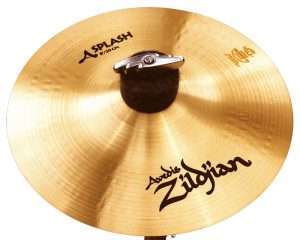
Splash cymbal ZILDJIAN 8` A SPLASH
Real china-type cymbals have a cylindrical or truncated-conical (i.e., rectangular in section) dome, and the edge of the cymbal is turned up, that is, against the main direction of the body’s curvature.
The china cymbals are available from 6″ to 27″ in diameter , with 12″ and smaller cymbals often referred to as china splash or mini chinese. As part of a drum kit, they are considered effect cymbals.
Both crash and ride china cymbals are played, and the latter require a dome, so some chinas have an inverted dome so that they can be hung with the dome up, but the inverted edges are pointing down and not hit.
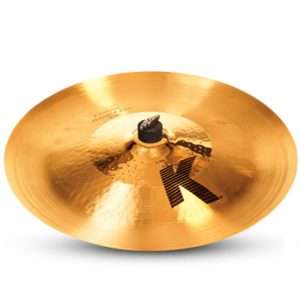
Plate type china ZILDJIAN 19` K` CUSTOM HYBRID CHINA
Tips from the store “Student” when choosing plates
- Think about where and how you will play the cymbals. Play them in the store as you normally would. You wo n’t be able to get the sound you want with just a light tap of your finger , so when choosing cymbals in the store, try to play the way you normally would. Create a work environment. Start with medium weight plates. From them you can move on to heavier or lighter ones until you find the right sound.
- Place the cymbals on racks and tilt them as they are tilted in your setup. Then play them as usual . This is the only way to “feel” the cymbals and hear their real sound.
- When testing cymbals , imagine that you are playing in a band and play with the same force, loud or soft, as you normally would. Listen for attack and sustain . Some cymbals perform best at a certain volume. Well, if you can compare the sound – bring your own cymbals to the store.
- Use your drumsticks.
- Other people’s opinions can be helpful, a salesperson in a music store can provide useful information. Feel free to ask questions and ask other people’s opinions.
If you hit your cymbals hard or play loudly, choose larger cymbals . They give a louder and more spacious sound. Smaller and lighter models are best suited for quiet to medium volume playing. Subtle crashes and not loud enough to star in a powerful game. Heavier cymbals have more impact resistance, resulting in a clearer, cleaner and punchier sound.
How to get great sound from cymbals?
To get great sound from cymbals, pay attention to a few simple things:
- Do not overtighten the clamping screw. Make sure the cymbal can vibrate freely.
- Set your plate at an angle slightly towards you.
- Always hit the cymbal from above . Avoid hitting the cymbal directly on its edge. This can easily break your cymbal .

- Try hitting the cymbal slightly away from its center with a slight twist of your wrist. This will help the sound “open up”.
- Choose the right stick weight and size that best suits your style and playing style. Lighter sticks are better suited for a more accentuated playing style and also contribute to the durability of your cymbals.
- Always carry your cymbals in a case or case.
How the plates are made



